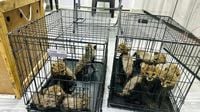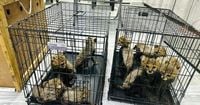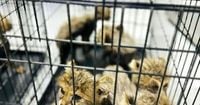In a dramatic rescue off the coast of Berbera, Somaliland, authorities intercepted a small dhow carrying eleven cheetah cubs destined for the illegal exotic pet trade. This operation, which took place on Sunday, September 28, 2025, stands as one of the largest confiscations of the species in recent memory, according to conservationists cited by ABC and other international news agencies.
Somaliland, a self-declared breakaway region of Somalia, has become a notorious transit hub for the illegal wildlife trade, particularly for cheetahs and leopards. These animals are often smuggled across the Gulf of Aden to meet the growing demand for exotic pets in Gulf countries. The recent rescue highlights both the scale of the problem and the dedicated efforts of local authorities and conservationists to combat it.
According to the Associated Press and ABC, the eleven cubs were found packed in bags that resembled sacks of potatoes, a grim testament to the brutal conditions endured by trafficked wildlife. The small wooden vessel was intercepted by the Somaliland coast guard, leading to the arrest of two local residents and three Yemenis suspected of involvement in the smuggling operation. The cubs were immediately transferred to a rescue center run by the Cheetah Conservation Fund (CCF), where they began receiving urgent medical care.
Laurie Marker, founder of the CCF, described the state of the cubs as dire. "The cubs were in very poor condition," Marker told reporters. "One died only a few hours after arriving at CCF’s centre, although in ICU and critical care administered. Another died the next day under same conditions. Two others are in critical care, one of which is in very bad state. The other seven are responding." Her words underscore the fragile health of these animals after enduring days of deprivation and stress, and the immense challenges faced by rescue teams.
The illegal trade in cheetahs is not just a local or regional issue—it is a global crisis that threatens the survival of the species. As Marker emphasized, "Cheetahs are not pets. They are wild animals, top predators and play an important role in the ecosystem." With fewer than 7,000 cheetahs remaining in the wild, every loss is significant. Marker added, "The rescue of cubs is critical in the fight to save the cheetah from extinction. With fewer than 7,000 cheetahs left in the wild, we can’t afford to lose a single one to the illegal pet trade."
Wildlife trafficking has become increasingly sophisticated, with smugglers employing elaborate methods to evade detection. The use of dhows—traditional wooden boats—enables traffickers to blend in with legitimate maritime activity along the Horn of Africa's busy coastline. Once captured, the animals are often transported in appalling conditions, with little regard for their health or survival.
Somaliland's authorities have responded with a series of crackdowns in recent years. Just this August, local police arrested two people and rescued another ten cheetah cubs that were also destined for the Gulf. Possession of wildlife is illegal in Somaliland, and law enforcement agencies have made it a priority to disrupt trafficking networks. However, the scale of the problem remains daunting. Hundreds of cheetahs and leopards are believed to have been smuggled from the Horn of Africa in recent years, with many never making it to their intended destinations alive.
Conservationists warn that the demand for exotic pets in Gulf countries is fueling a lucrative black market, placing enormous pressure on already vulnerable wildlife populations. The removal of top predators like cheetahs from their natural habitats has cascading effects on ecosystems, disrupting the balance of prey and predator and threatening biodiversity. As Marker put it, "Wildlife belongs in the wild. Please help us stop the illegal wildlife pet trade in cheetahs and other wildlife species being illegally traded around the world."
The Cheetah Conservation Fund, which now cares for 128 rescued cheetahs, has become a vital lifeline for animals caught up in the trade. The organization works closely with local and international partners to provide medical care, rehabilitation, and—where possible—reintroduction to the wild. But the challenges are immense. Many rescued cubs arrive severely malnourished and traumatized, requiring intensive and prolonged care. The recent rescue, for example, saw the cubs being reintroduced to food slowly, starting with fluids, due to their weakened state.
Efforts to combat wildlife trafficking in Somaliland are complicated by the region's political status and limited resources. As a self-declared independent state not internationally recognized, Somaliland struggles to access the full range of support available to other nations. Nevertheless, local authorities have shown a commitment to tackling the problem, often working in partnership with NGOs and international agencies.
The broader context of wildlife trafficking in the Horn of Africa is alarming. According to reports from ABC and the Associated Press, the region has become a hotspot for illegal trade, with networks spanning multiple countries and continents. The Gulf of Aden serves as a critical corridor, linking African source countries with wealthy buyers in the Middle East. Conservationists have long voiced concerns about the impact of this trade, not only on individual species but on entire ecosystems.
Despite these challenges, there are signs of progress. Increased awareness, tougher enforcement, and international cooperation have led to more frequent rescues and higher rates of prosecution for traffickers. The recent operation off Berbera is a testament to what can be achieved when authorities and conservationists work together. Still, the battle is far from over.
The plight of the cheetah serves as a stark reminder of the interconnectedness of global ecosystems and the far-reaching consequences of human actions. Every cub rescued is a small victory, but the ultimate goal remains the preservation of wild populations in their natural habitats. As Laurie Marker and her colleagues at the CCF continue their work, they hope that stories like this will inspire greater public support and stronger action against the illegal wildlife trade.
For now, the fate of the seven surviving cubs hangs in the balance. With expert care and a bit of luck, they may yet recover and, one day, return to the wild where they belong. Their story is a testament to resilience—both theirs and that of the people fighting to save them.


